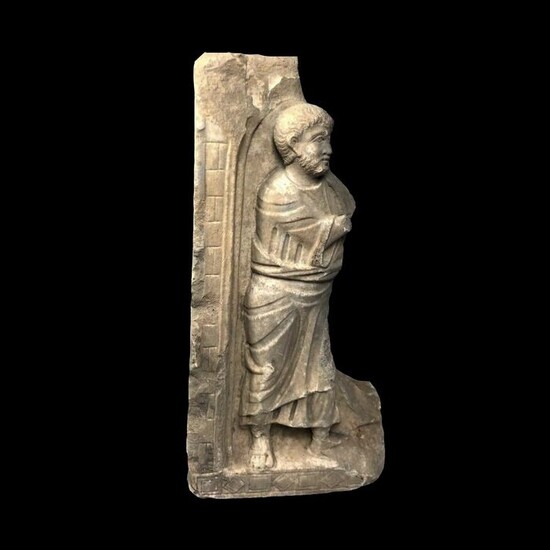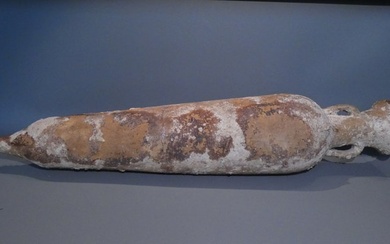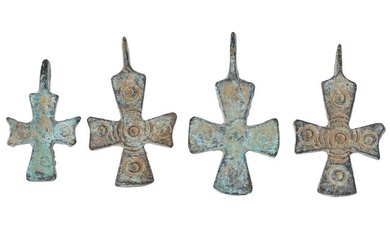Ancient Roman/Early Byzantine Fragment of a Sarcophagus with an Apostle H: 57cm (4th century A.D. )
Fragment of a sarcophagus CULTURE: Roman, most probably France. PERIOD: 4th century AD MATERIAL: Marble DIMENSIONS: Height 57 cm; length 28 cm; depth 40 cm PROVENANCE: Old private collection of Sr. R. I. , Providence, USA. Since 1960. CONDITION: A fragment in a good state of preservation, without restoration. DESCRIPTION: A marble corner carving from the case of a sarcophagus. Given the iconographic style, it must be from the Paleochristian period. The figure in semi-profile in high relief in the front section is that of an apostle. He is wearing a long tunic, and is holding his arms forward, with legs slightly separated. The figure is framed behind just before the corner by an architectonic structure, a vertical wall with well-defined blocks. The upper section arches over the figure. Part of a side of the sarcophagus is conserved connected to the figure. This is decorated with a “fish scales” pattern, a Paleochristian symbol given the name ichthus or ichthys, an acronym in Greek signifying Jesus Christ, Son of God, Saviour. Both iconographies are commonly found on other sarcophagi from the same period. These characteristics indicate that the piece is of the style of sarcophagi called “City Gates Sarcophagi”. The best-known example is the one with three of its panels conserved in the Louvre Museum, and the fourth panel is in the Palazzo dei Conservatori in Rome. This sarcophagus was found in the mausoleum of Anicius, below the apse of Saint Peter’s Basilica in the Vatican. This “City Gates Sarcophagus” marks the emergence of early Christian art, in the late fourth century, and the creation of Christian imagery rooted in Greco-Roman models. On the main face, Christ presents Peter with the Law in the presence of Saint Paul and the apostles. Moreover, given the fish scale decoration on the side of the fragment, it is easy to attribute its production to the workshops in the south of Galia, probably Massalia , as this is the area where examples of sarcophagi stylistic resources have been found, for example, the sarcophagus with a scene of teaching conserved in the Louvre Museum (inventory No. NIII 2296, found at Rignieux-le-Franc (Ain, France) or the sarcophagus of the tomb of two anonymous saints found in the necropolis of a Paleochristian church in the Rue Malaval (Marseille, France) . It was usual in Roman culture to bury the dead in coffins, most of which were made of marble, while there are also some examples made from lead. All had some sort of decoration, even if this was merely a description or a figurative or geometric decoration. The most notable ones were so large that the figures in relief were more than a metre high. There are quite a number that have been worked so deeply that they have almost free-standing figures. Although the decorative motifs of the container and the lid varied depending on the zone where they were found, it is easy to recognise that they are sarcophagi from the Roman period or culture. This sarcophagus must be placed at the end of the 4th century as Christianity was legalized by the Edict of Milan in 313 AD, it gradually came out of hiding and became the state religion of the Roman Empire in 380, under Theodosis I. Early Christian art began to flourish. However, in the absence of any figurative tradition in Jewish art, the Christian imagery that was created took its inspiration from Greek and Roman models. PARALLELS: -\t. Sarcophagus with a teaching scene. End of the 4th century AD. White marble. Found at Rignieux-le-Franc. Louvre Museum, Paris. Inventory No. NIII 2296 (usual number Ma 2958) . -\t“City Gates” sarcophagus End of 4th century AD. White marble. Found in Rome. Louvre Museum, Paris. Inventory No. i MR 688 (usual number Ma 2980) . -\t. Four marble panels, three decorated with interlaced fish scales. These were part of two twin sarcophagi of rose limestone. Found in the necropolis of a Paleochristian church in the Rue Malaval en Marseille, France. BIBLIOGRAPHY: -\t. BARATTE F. METZGER C. Musée du Louvre. Catalogue de sarcophages en pierre d'époques romaine et paléochrétienne. Paris. 1985. pp. 312 - 316. Notes: M. E. The seller guarantees that he acquired this piece according to all national and international laws related to the ownership of cultural property. Provenance statement seen by Catawiki. The seller will take care that any necessary permits, like an export license will be arranged, he will inform the buyer about the status of it if this takes more than a few days. The piece includes authenticity certificate. The piece includes Spanish Export License (Passport for European Union) - If the piece is destined outside the European Union a substitution of the export permit should be requested. This process could take between 1 and 2 months.
[ translate ]View it on
Estimate
Time, Location
Auction House
Fragment of a sarcophagus CULTURE: Roman, most probably France. PERIOD: 4th century AD MATERIAL: Marble DIMENSIONS: Height 57 cm; length 28 cm; depth 40 cm PROVENANCE: Old private collection of Sr. R. I. , Providence, USA. Since 1960. CONDITION: A fragment in a good state of preservation, without restoration. DESCRIPTION: A marble corner carving from the case of a sarcophagus. Given the iconographic style, it must be from the Paleochristian period. The figure in semi-profile in high relief in the front section is that of an apostle. He is wearing a long tunic, and is holding his arms forward, with legs slightly separated. The figure is framed behind just before the corner by an architectonic structure, a vertical wall with well-defined blocks. The upper section arches over the figure. Part of a side of the sarcophagus is conserved connected to the figure. This is decorated with a “fish scales” pattern, a Paleochristian symbol given the name ichthus or ichthys, an acronym in Greek signifying Jesus Christ, Son of God, Saviour. Both iconographies are commonly found on other sarcophagi from the same period. These characteristics indicate that the piece is of the style of sarcophagi called “City Gates Sarcophagi”. The best-known example is the one with three of its panels conserved in the Louvre Museum, and the fourth panel is in the Palazzo dei Conservatori in Rome. This sarcophagus was found in the mausoleum of Anicius, below the apse of Saint Peter’s Basilica in the Vatican. This “City Gates Sarcophagus” marks the emergence of early Christian art, in the late fourth century, and the creation of Christian imagery rooted in Greco-Roman models. On the main face, Christ presents Peter with the Law in the presence of Saint Paul and the apostles. Moreover, given the fish scale decoration on the side of the fragment, it is easy to attribute its production to the workshops in the south of Galia, probably Massalia , as this is the area where examples of sarcophagi stylistic resources have been found, for example, the sarcophagus with a scene of teaching conserved in the Louvre Museum (inventory No. NIII 2296, found at Rignieux-le-Franc (Ain, France) or the sarcophagus of the tomb of two anonymous saints found in the necropolis of a Paleochristian church in the Rue Malaval (Marseille, France) . It was usual in Roman culture to bury the dead in coffins, most of which were made of marble, while there are also some examples made from lead. All had some sort of decoration, even if this was merely a description or a figurative or geometric decoration. The most notable ones were so large that the figures in relief were more than a metre high. There are quite a number that have been worked so deeply that they have almost free-standing figures. Although the decorative motifs of the container and the lid varied depending on the zone where they were found, it is easy to recognise that they are sarcophagi from the Roman period or culture. This sarcophagus must be placed at the end of the 4th century as Christianity was legalized by the Edict of Milan in 313 AD, it gradually came out of hiding and became the state religion of the Roman Empire in 380, under Theodosis I. Early Christian art began to flourish. However, in the absence of any figurative tradition in Jewish art, the Christian imagery that was created took its inspiration from Greek and Roman models. PARALLELS: -\t. Sarcophagus with a teaching scene. End of the 4th century AD. White marble. Found at Rignieux-le-Franc. Louvre Museum, Paris. Inventory No. NIII 2296 (usual number Ma 2958) . -\t“City Gates” sarcophagus End of 4th century AD. White marble. Found in Rome. Louvre Museum, Paris. Inventory No. i MR 688 (usual number Ma 2980) . -\t. Four marble panels, three decorated with interlaced fish scales. These were part of two twin sarcophagi of rose limestone. Found in the necropolis of a Paleochristian church in the Rue Malaval en Marseille, France. BIBLIOGRAPHY: -\t. BARATTE F. METZGER C. Musée du Louvre. Catalogue de sarcophages en pierre d'époques romaine et paléochrétienne. Paris. 1985. pp. 312 - 316. Notes: M. E. The seller guarantees that he acquired this piece according to all national and international laws related to the ownership of cultural property. Provenance statement seen by Catawiki. The seller will take care that any necessary permits, like an export license will be arranged, he will inform the buyer about the status of it if this takes more than a few days. The piece includes authenticity certificate. The piece includes Spanish Export License (Passport for European Union) - If the piece is destined outside the European Union a substitution of the export permit should be requested. This process could take between 1 and 2 months.
[ translate ]




